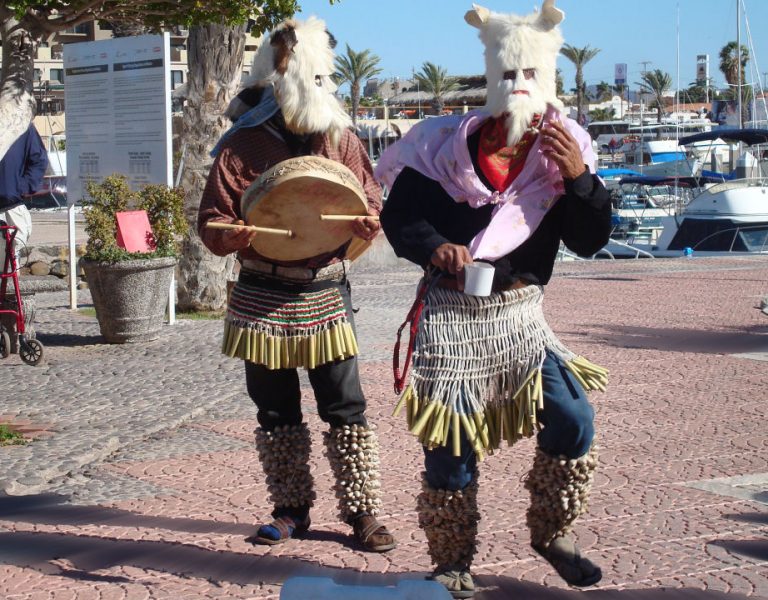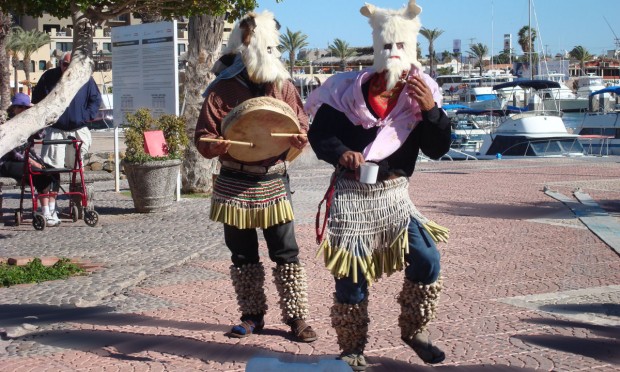By MoKa Hammeken
“Is it that time of year already?” This is what a friend exclaimed when she could hear the sound of drums and rattles, and perceive two men adorning masks in the distance. Definitely, time flies and the Fariseos, traditional figures from the Sonoran panorama, year after year come back promptly at the time of Lent.
Who are these men and why do they do this? These are the well-known Fariseos or “Chapayecas” (meaning long-nosed in Yaqui), representative of a custom from the Yaqui tribe of Sonora. It is a tradition full of symbols and representation that dates back to the colonial era, from around the 17th century and the Jesuits. In teaching Catholic doctrine to different pueblos, theatrical representations were valuable and through time these fused with indigenous beliefs, resulting in a colorful way to interpret and bring specific dates to life.
They are called Fariseos (Pharisees) in being the most hated characters from the Passion of the Christ, a representation of the evil of hypocrisy, and the absurd, which is way the Yaqui take on this role as a mandate (a sacrifice offered to God for a special request). They suffer and expunge their sins. Fariseos make their own masks, which they must wear for forty days as they go through pueblos. The Fariseos signify commitment, discipline, and are always accompanied by a “corporal,” who is similar to a godparent who cares for them and assures they do not fall for temptation. This role is for three years, but can be extended for life.
During the festivities of Holy Week, young men and adults adorn particular dress and cover their faces with handmade masks of cow, goat, and deer hides so they are unrecognizable. They are prohibited from speaking and can only communicate through signs. Under the mask it is said they have a rosary cross in their mouth, which is worn around the neck, in order to prevent them from speaking as well as to prevent sin from entering or to fall into temptation. It is said that when a Yaqui man goes to put on his mask, he must lay on the ground and from there place it on their head, simulating as if he were dead and now lives through the character of the mask.
There are those who assure that when Fariseos ask for money this doesn’t have much to do with raising funds, affirming they are very spiritual people; rather, begging is to represent the roles of evil and frugality.
It is not until Black Saturday (Easter Saturday) when the dress and masks worn throughout Lent are removed, and burned in a fire. Then, flowers that represent Black Saturday are thrown upon the burning masks, symbolizing the sinner’s re-encounter with God.
This is a broad picture of the Fariseos, which can vary depending on the region; there are small details that differentiate among each Yaqui group as it is very important to define roots and territories. So, once this period is gone, silence returns to the streets and it won’t be until next year when these mysterious men reappear, and the drum and the rattle remind us of their shocking masks, theirs and ours.
Los Fariseos
Por MoKa Hammeken
“Is it that time of the year already?” Es lo que dijo una amiga al escuchar el sonido de tambores y sonajas y ver a dos hombres con máscaras a lo lejos. Definitivamente, el tiempo vuela y estos personajes típicos del panorama sonorense, año con año puntualmente resurgen, con la cuaresma.
Sin embargo la pregunta de muchos también regresa ¿Quienes son estos hombres y por qué lo hacen? Son los llamados Fariseos o “Chapayecas” (“nariz larga” en lengua yaqui) y esta es una costumbre de la tribu Yaqui de Sonora. Es una tradición llena de símbolos y representaciones que se remonta a la época colonial, alrededor del siglo XVII, donde los jesuitas, para enseñarles la doctrina católica a los diferentes pueblos, se valían de representaciones teatrales, las cuales, con el paso del tiempo se fusionaron con sus creencias, dando como resultado una colorida forma de interpretar y encarnar estas fechas.
Se dicen Fariseos por son los personajes más odiados durante la Pasión de Cristo, por ende son la representación de todo lo malo de la hipocresía, de lo burdo y de ahí que el yaqui tome esa posición como una manda (sacrificio que se le ofrece a dios por algunas peticiones en especial ); se sufre y se expían los pecados. Él Hace la máscara con sus propias manos, que ha de portar por cuarenta días mientras anda por los pueblos.
Tienen significado de compromiso, disciplina y siempre van acompañados de un “cabo” que hace las veces de padrino que los cuida y vigila de no caer en tentaciones. Esta manda se hace por tres años, pero puede extenderse de por vida. En los festejos de la Semana Santa, participan hombres jóvenes y adultos vistiéndose de forma especial y cubriéndose la cara con máscaras confeccionadas en la localidad con cueros de vaca, de cabra y de venado, para no ser reconocidos. Tienen prohibido hablar y para comunicarse se valen de señas. Debajo de la máscara se dice que nl la boca tienen la cruz del rosario que tienen colgado al cuello, para si evitar hablar como también evitar que entre el pecado y caer en la tentación.
Hay quienes aseguran que el pedir limosna no tiene mucho que ver con recaudar dinero puesto que afirman que son gente de espíritu muy desprendido si no más bien es el asunto de representar el papel de malvado y avaro. Se dice que siempre que el hombre yaqui va a ponerse la máscara debe acostarse en el suelo y desde ahí colocarla en su cabeza, simulando que está muerto y ahora vive en el personaje de la máscara.
No es sino hasta el Sábado de Gloria, un día de regocijo, cuando se despojan de las vestiduras y máscaras que llevaron durante la cuaresma y, a modo de pecados y ofensas, se queman en una hoguera . Luego arrojan flores que simbolizan el Sábado de gloria y el reencuentro del pecador con Dios. Esto es a grosso modo, pues puede variar algunas cosas dependiendo de la región de la que vengan; pequeños detalles que hacen que cada grupo yaqui se diferencie de otro, muy importante a la hora de definir raíces y territorios.
Entonces ya pasado este tiempo, vuelve el silencio a las calles y no será hasta el próximo año, cuando estos misteriosos hombres reaparezcan, y el tambor y la sonaja nos recuerden sobre las impactantes máscaras; las suyas y las nuestras.

